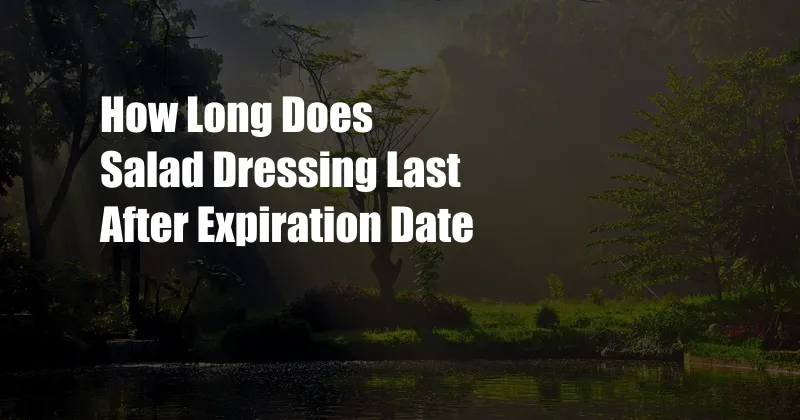
How Long Does Salad Dressing Last After Expiration Date?
As a food enthusiast, I’ve often pondered the shelf life of salad dressings. While we all know that consuming expired food can lead to unpleasant consequences, understanding the true lifespan of these condiments is essential to avoid unnecessary waste. In this comprehensive guide, we will delve into the nitty-gritty of salad dressing expiration dates, exploring their significance, implications, and the latest industry trends.
Before we dive into the specifics, it’s important to dispel a common misconception: expiration dates are not synonymous with spoilage. Rather, they represent the manufacturer’s estimated timeframe during which the product will retain its optimal quality, flavor, and nutritional value. After this date, while the dressing may not be harmful to consume, it may not taste as intended and could have lost some of its nutrients.
Decoding the Expiration Date
Typically, commercially produced salad dressings will have two types of expiration dates: “Best Before” and “Use By.” “Best Before” indicates the recommended timeframe for consuming the dressing at its peak quality, while “Use By” denotes the date beyond which the product should not be consumed due to potential safety concerns.
It’s important to note that these dates are based on unopened products. Once a dressing is opened, its shelf life may be significantly reduced due to exposure to air and bacteria. As a general rule of thumb, most opened salad dressings will last for about 2 weeks when refrigerated properly.
Factors Affecting Salad Dressing Shelf Life
Several factors can influence the shelf life of salad dressings, including:
- Ingredients: Dressings made with fresh ingredients, such as herbs and spices, will generally have a shorter shelf life than those made with processed ingredients.
- Type of dressing: Creamy dressings, such as ranch and blue cheese, tend to have a shorter shelf life than oil-based dressings, such as vinaigrette and Italian.
- Packaging: Dressings stored in glass or opaque plastic containers will last longer than those in clear plastic containers, as light exposure can degrade the dressing’s quality.
- Storage conditions: Salad dressings should always be refrigerated at or below 40°F (4°C) to maximize their shelf life.
Tips for Extending Salad Dressing Life
In addition to following the expiration dates and storage guidelines, here are a few tips for extending the shelf life of your salad dressings:
- Transfer dressings to airtight containers to prevent air exposure.
- Avoid double-dipping to prevent bacteria from entering the dressing.
- Discard any dressing that has changed in color, texture, or smell.
FAQ on Salad Dressing Expiration Dates
Q: Can I use salad dressing after the “Use By” date?
A: It is not recommended to consume salad dressing after the “Use By” date due to potential safety concerns.
Q: How long can I store opened salad dressing in the refrigerator?
A: Most opened salad dressings will last for about 2 weeks when refrigerated properly.
Q: What are the signs of spoiled salad dressing?
A: Signs of spoiled salad dressing include changes in color, texture, or smell.
Q: How can I tell if my salad dressing is still good?
A: If your salad dressing has not changed in color, texture, or smell, it is likely still good to consume.
Conclusion
Understanding the shelf life of salad dressings is crucial for ensuring food safety and minimizing waste. By following the expiration dates, proper storage practices, and the tips outlined in this article, you can extend the lifespan of your favorite dressings and enjoy them at their peak quality for longer. Remember, when in doubt, always err on the side of caution and discard any dressing that shows signs of spoilage.
Are you interested in learning more about food preservation and shelf life? I encourage you to explore other articles on my blog or reach out to me with any specific questions you may have.